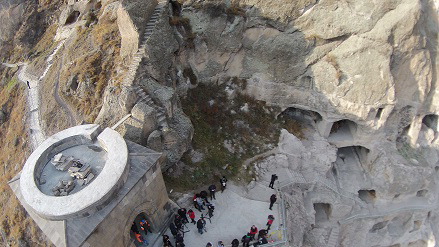Faculty and students at Ilia State University (ISU) learned how to use the VR-based software tools by receiving training at KeckCAVES (the W.M. Keck Center for Active Visualization in the Earth Sciences) at the University of California, Davis. ISU has also incorporated advanced visualization tools in their undergraduate and graduate courses. A differential GPS system and Quad-copter drone for aerial visualization were introduced as practical tools in several courses and are widely used by students at different levels.
The PEER team continued an investigation of active faults through field work at the fault scarp near the Tbilisi-Gori highway, between the villages of Okami and Igoeti. This previously unknown fault was discovered by the project team in an area with terrain that is less folded and unseparated, thus outcrops in the region are very rare. In addition, researchers identified a thrust fault in middle of a trench that cut through all soil layers, except the first.
The team also made progress towards constructing 3D models of the Bronze Age settlement Tells in the Kolkheti lowland, an area that shows traces of having undergone dramatic changes in the environment during the past millennia. Researchers were able to use drone-mounted photography to create a digital elevation model, using six Ground Control Points to achieve a high degree of precision. In the Shiraki plain, the team was able to reconstruct the paleoenvironment of the area and identify traces of natural catastrophes and their effect on the early formations in the Southern Caucasus.
The researchers presented some of their work at the 2016 American Geophysical Union Fall Meeting. The PEER team developed new collaborations with researchers and students at Bridgewater State University in Massachusetts, including submission of a joint proposal for a National Science Foundation International Research Experiences for Students (IRES) project. The team also made contact with ATel LLC, a company that specializes in development of advanced tools for e-learning.
PublicationsG. Sokhadze, M. Floyd, T. Godoladze, R. King, E.S. Cowgill, Z. Javakhishvili, G. Hahubia, and R. Reilinger. 2018. Active convergence between the Lesser and Greater Caucasus in Georgia: Constraints on the tectonic evolution of the Lesser–Greater Caucasus continental collision.
Earth and Planetary Science Letters 481: 154-161.
https://doi.org/10.1016/j.epsl.2017.10.007
Eric Cowgill, Adam M. Forte, Nathan Niemi, Boris Avdeev, Alex Tye, Charles Trexler, Zurab Javakhishvili, Mikheil Elashvili, and Tea Godoladze. 2016. Relict basin closure and crustal shortening budgets during continental collision: An example from Caucasus sediment provenance.
Tectonics 35(12): 2918-2947.
https://doi.org/10.1002/2016TC004295 N. Jorjiashvili, M. Elashvili, M. Gigiberia, and I. Shengelia. 2016. Seismic hazard analysis of Adjara region in Georgia.
Natural Hazards 81: 745–758.
https://doi.org/10.1007/s11069-016-2167-6
Eric Cowgill, Adam M Forte, Nathan A Niemi, Boris Avdeev, AR Tye, Charles Cashman Trexler, Zurab Javakhishvili, Mikheil Elashvili, and Tea Godoladze. 2016. Relict basin closure accommodates continental convergence with minimal crustal shortening or deceleration of plate motion as inferred from detrital zircon provenance in the Caucasus. Presentation at the American Geophysical Union, Fall Meeting 2016, abstract #T51A-2883.
Giorgi Boichenko, Eric Cowgill, Tim Stahl, Chad Trexler, Luka Tsiskarishvili, Lasha Sukhishvili, Giorgi Sokhadze, Giorgi Akhalaia, Tea Godoladze, Mikheil Elashvili, and Salome Gogoladze. 2016. A paleoseismic investigation of a frontal foreland thrust in the Greater Caucasus. Presentation at the
American Geophysical Union, Fall Meeting 2016, abstract #T51A-2876.
M. Elashvili, Z. Javakhishvili, T. Godoladze, A. Karakhanyan, L. Sukhishvili, E. Nikolaeva, G. Sokhadze, and M. Avanesyan. 2012. Historical and Paleo Events as an input for Seismic and Associated Natural Hazard Assessment of Javakheti highland (South Georgia). Presentation at the American Geophysical Union, Fall Meeting 2012, abstract id. S44C-03.





